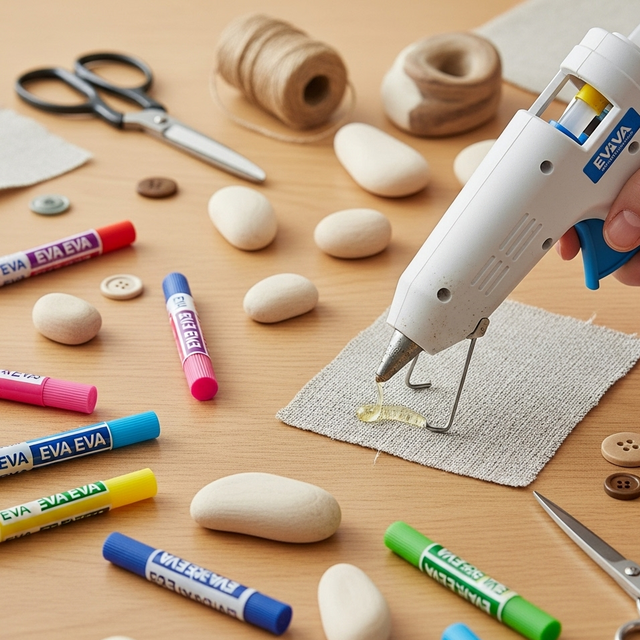Ozito Trigger-Flow Hot Glue Gun 10 W is a reliable compact hot melt glue gun for quick bonding and model making chosen for home repairs, trade work, and craft builds when you want a bond you can trust. Designed for Australian conditions, it balances strength, ease of use, and clean application so you can get professional results without special tools. The 10 W pack is ideal for general work and keeps neatly in a toolbox or caddy.
Why choose Ozito Trigger-Flow for your next project
Everyday jobs often involve mixed materials and imperfect surfaces. Ozito Trigger-Flow Hot Glue Gun 10 W has been formulated to wet out well, grab quickly, and cure to a tough finish that resists movement and contact stress. It maintains bond integrity across common temperature swings and has dependable resistance to moisture and most household chemicals. Whether you are fixing, building, sealing, or assembling, this product gives you confidence from first squeeze through final set.
Best for
Cardboard displays and craft
Light repairs and cable dressing
Attaching trims, felt, and fabric accents
Suitable surfaces
The adhesive works well on the following surface types when properly prepared:
Card, paper, fabric
Wood trim and plastics that tolerate hot melt
Ceramic ornaments
Surface preparation
Good preparation is the key to a long lasting repair. Remove loose material, dust, and grease. Wipe glossy areas with methylated spirits or an approved cleaner and allow to dry. On very smooth plastics and metals, lightly roughen with fine abrasive paper to give the adhesive a mechanical key. Dry fit parts first and mark alignment points so you can assemble accurately within the open time. If bonding porous materials, ensure both faces are dry and free of surface chalking.
How to use
Check fit and plan clamping. Do a trial run without adhesive so you know the order of steps.
Apply a thin, continuous bead to one surface. For wide pieces, use a zig zag pattern to maximise wetting.
Bring surfaces together within the stated open time of open time is short, assemble parts promptly after application. Reseat once if needed, then hold steady.
Apply even pressure using clamps, tape, weights, or temporary fasteners. Avoid squeezing all adhesive out of the joint.
Allow to cure undisturbed. Initial handling strength will develop as the adhesive sets, with a full cure reached based on the chemistry described below.
Cure profile
Hot melt sets as it cools, giving fast handling strength. Full strength is reached once the bead has cooled through.
Temperature and environmental performance
Operate in a dry area. Avoid use on heat sensitive foams that may melt. Avoid application to very cold, sweating, or waterlogged surfaces. For outdoor use protect fresh bonds from rain until the skin has formed and the core has progressed in cure. Once fully cured, the bond resists normal weathering, splash water, and intermittent UV exposure based on the substrate and paint systems used.
Clean up and finishing
Peel away stray strands after cooling. Protect worktops with a mat. When cured, excess can be carefully trimmed or sanded. For painted finishes, allow the adhesive to fully cure before priming. Test paint on a small area to confirm compatibility and drying behaviour.
Coverage guide
Coverage varies with bead size, surface porosity, and technique. As a general guide, a 3 mm bead yields approximately 10 to 12 linear meters per 310 mL cartridge. Smaller packs scale proportionally. Gaps, rough edges, and highly absorbent materials will reduce coverage. Plan an extra margin for offcuts and practice passes.
Tips for best results
Work within the recommended open time so the adhesive can properly wet the surfaces.
Use light clamping pressure to keep parts aligned while maintaining a film thickness for strength.
For very porous substrates, apply a thin precoat as a primer layer and allow it to tack before final assembly.
Keep joint lines clean by masking edges with painter tape and removing it before the adhesive skins.
Where movement or vibration is expected, design the joint to share load across a large area.
Troubleshooting
Poor adhesion: Check for oil, release agents, or surface dust. Reclean and lightly abrade if necessary.
Slow cure: Low temperature and low humidity extend cure time. Maintain moderate conditions for best results.
Visible squeeze out: Wipe fresh material with a suitable solvent and a soft cloth. Once cured, trim carefully.
Bond line prints through paint: Allow a full cure, then prime and apply thin coats of paint, allowing proper drying between coats.
Storage and shelf life
Unplug and allow to cool before storage. Keep glue sticks sealed from dust. Always check the pack for a lot code and use by guidance. Reseal immediately after use and store upright. Dispose of empty containers responsibly.
Safety
Read the label before use. Wear gloves when handling uncured material. Provide ventilation in enclosed areas. Avoid contact with skin and eyes. Keep out of reach of children and pets. If sensitivity occurs, stop use and seek advice. Do not ingest. First aid directions and detailed handling information are available on the package and the safety data sheet.
Frequently asked questions
Can I bond dissimilar materials? Yes, provided each surface is clean and sound. Differences in expansion are managed by the adhesive film thickness and the inherent flexibility after cure.
Is clamping required? Light clamping improves alignment and final strength. Excessive pressure can starve the joint of adhesive which reduces performance.
Is the bond water resistant? Once cured the bond resists splash water and routine humidity. For permanent immersion choose an adhesive designed for underwater service and follow the manufacturer guidance.
Planning your job
Measure twice and cut once. Dry assemble parts so you can confirm squareness and alignment before adhesive is involved. Keep rags, clamps, and spacers ready. If you are new to the product, test on offcuts to get a feel for bead size and squeeze out. A consistent 1 to 2 mm bond line is a good starting point for most rigid materials. Thicker lines help when surfaces are uneven. Avoid starving the joint by pressing too hard without giving the adhesive a place to reside.
Responsible use
Choose an adhesive that suits the materials and the environment the finished piece will face. If a joint will be submerged, carry structural loads, or be exposed to strong chemicals, check the technical data sheet for specific guidance. Many general purpose products are perfect for day to day work, while specialised tasks call for a system designed and tested for that environment. Using the right product first saves time, money, and rework.
Aftercare and maintenance
Adhesive joints are remarkably strong when used correctly. Design repairs so that routine loads are shared across a generous area. Where heavy vibration is present, pair the adhesive bond with appropriate mechanical fasteners. Keep cleaning chemicals mild, and avoid abrasive pads on visible joints. If a bond will be repainted, choose flexible paint where movement is expected, and keep edges sealed to prevent dirt tracking along the bond line.
Recycling and disposal
Allow empty containers to cure before disposal. Check local council guidance for recycling of plastics and metal cartridges. Never pour uncured product into drains or soil. Wipe tools on scrap material and let residue harden before placing in general waste. Smart handling keeps the workspace clean and reduces environmental impact.
Read more less










